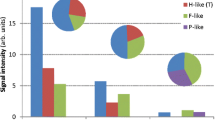Abstract
Humic (HA) and fulvic (FA) acids isolated from mangrove sediments of Sundarban, the largest delta on earth in the estuarine phase of the river Ganges, were studied and attempts were made to characterize their binding sites by quenching of Synchronous fluorescence (SyF) bands with Fe (III) and Cu (II). A modified Stern-Volmer relationship applicable for static quenching was applied for the determination of conditional stability constants and the data were compared with those determined by potentiometric titration. In the excited state HA and FA showed different acidity constant compared to the ground state. Values of the conditional stability constant (log Kc) for Fe (III) and Cu (II) indicated that binding sites were bidentate in nature. FA were better chelators than the HA fractions. High energy binding sites of both FA & HA were occupied by Fe(III) and the low energy binding sites, mainly responsible for mobilization and immobilization of metal, were occupied by Cu(II).
Similar content being viewed by others
References
Bell J.E. 1981. Spectroscopy in Biochemistry, Vol. 1, CRC Press, London.
Bell J.E. and Dalziel K. 1975. Studies of coenzyme binding to rabbit muscle glyceraldehydes-3 phosphate dehydrogenase. Biochim. Biophys. Acta 391: 249-255.
Bhat G.A., Weber J.H., Tuschall J.R. and Brezonik P.L. 1982. Exchange of comments on evaluation of the copper anodic stripping voltammetry complexometric titration for complexing capacities and conditional stability constants. Anal. Chem. 54: 2116-2117.
Brown G.K., MacCarthy P. and Leenheer J.A. 1999. Simultaneous determination of Ca, Cu, Ni, Zn and Cd binding strengths with fulvic acid fractions by Schubert's methods. Analytica Chimica Acta 402(1–2): 169-181.
Cotton F.A., Wilkinson G., Murillo C.A. and Bochmann M. 1999. Advanced Inorganic Chemistry, John Wiley & Sons, Inc, New York, p. 29.
De T.K., Ghosh S.K., Jana T.K. and Choudhury A. 1991. Phytoplankton bloom in the Hooghly estuary. Indian J. Mar. Sci. 20: 134-137.
Dowson R., Liebezeigt G. and Josefsson B. 1983. Determination of amino acids and carbohydrates. In: Grasshoff K., Ehrhardt M. and Kremling K. (eds.), Methods of Seawater Analysis, Verlag Chemie, Germany, pp. 314-342.
Dyer R.J. 1997. Application of Absorption Spectroscopy of Organic Compounds. Prentice Hall of India Pvt. Ltd., New Delhi.
Esteves da Silva J.C.G., Machado A.A.S.C. and Garcia T.M.O. 1995. Beryllium (II) as a probe for study of the interactions of metals and Fulvic acids by synchronous fluorescence spectroscopy. Appl. Spec. 49(10): 1500-1506.
Esteves da Silva J.C.G. and Machado A.A.S.C. 1996a. Characterization of the binding sites for Al (III) and Be (II) in a sample of marine fulvic acid. Marine Chem. 54: 293-302.
Esteves da Silva J.C.G., Machado A.A.S.C., Romos M.A., Arce F. and Rey F. 1996b. Quantitative study of Be (II) complexation by soil fulvic acids by molecular fluorescence spectroscopy. Envir. Sci. Technol. 30: 3156-3160.
Gregor H.P., Luttinger L.B. and Loebl E.M. 1955. Metal polyelectrolyte complexes. 1. The polyacrylic acid-copper complex. J. Phys. Chem. 59: 34-39.
Koroleff F. 1983. Determination of Silicon. In: Grassohoff M., Ehrhardt and Kremling K. (eds.), Methods of Seawater Analysis, Verlag Chemie, Germany, pp. 174-183.
Lowry G.H., Rosebrough N.J., Farr A.L. and Randal R.J.I. 1951. Protein Measurement with folin phenol reagent. J. Biol. Chem. 193: 265-275.
Leifer A. 1988. The Kinetics of Environmental Aquatic Photochemistry, American Chemical Society. Washington, DC, 304 pp.
Melcer M.E., Zalewski M.S., Hassett J.P. and Brisk M.A. 1989. Change-transfer interaction between dissolved humic materials and chloranil. In: Suffet H. and MacCharthy P. (eds.), Aquatic Humic Substances, American Chemical Society, Washington, pp. 173-183.
Morel F.M.M. and Hering J.G. 1993. Principles and Applications of Aquatic Chemistry. Jhon Wiley and Sons, Inc, New York, 371 pp.
Piper C.S. 1950. Soil and Plant Analysis. Inter Science Publication, New York, 67 pp.
Rohatgi-Mukherjee K.K. 1997. Fundamentals of Photochemistry (Revised edn.). New Age International Publication, New Delhi, 144 pp.
Rashid M.A. 1985. Geochemistry of Marine Humic Compounds. Springer, New York.
Rice A.J. and MacCarthy P. 1989. Characterization of a stream sediment Humin. In: Suffet H. and MacCarthy P. (eds.), Aquatic Humic Substances. American Chemical Society, Washington, pp. 41-54.
Sardessai S. 1989. Humic and fulvic acids in sediments of the Hooghly estuary and some coastal areas in the Northen Bay of Bengal. Indian J. Mar. Sci. 18: 16-20.
Sarkar B., Das U., Bhattachrya S. and Bose S. 1994. The quenching of lumichrome fluorescence by β-Cyclodextrin: Evidence for inclusion complex. Bull. Chem. Soc. Japan 68: 1807-1809.
Stevenson F.J. 1976. Stability constants of Cu (II), Pb (II) and Cd (III) complexes with humic acids. Soil Sci. 40: 665-672.
Silva C.S.P.C.O., Esteves da Silva J.C.G. and Machado A.A.S.C. 1994. Evolving factor analysis of synchronous fluorescence spectra of fulvic acid in the presence of Aluminium. Appl. Spect. 48: 363-372.
Stumm W. 1995. The inner sphere surface complex. In: Huang C.P., O'Melia C.R. and Morgan J.J. (eds.), Aquatic Chemistry. American Chemical Society, Washington, DC, pp. 1-32.
Shuman M.S., Brezonik P.L. and Tuschall J.R. 1982. Exchange of comments on evaluation of the copper anodic stripping voltammetry complexometric titration for complexing capacities and conditional stability constants. Anal. Chem. 54: 998-1001.
Turner D.R., Varney M.S., Whitfield M., Mantoura R.F.C. and Riley J.P. 1986. Electrochemical Studies of copper and lead complexation by fulvic acid. 1. Photometric measurements and critical comparison of metal binding models. Geochimica et Cosmochimica Acta 50: 289-297.
Wilson D.E. and Kinney P. 1977. Effects of polymeric change variations on the proton metal ion equilibria of humic materials. Limnol. Oceanogr. 22(2): 281-289.
Author information
Authors and Affiliations
Corresponding author
Rights and permissions
About this article
Cite this article
Ghatak, H., Mukhopadhyay, S., Jana, T. et al. Interactions of Cu (II) and Fe (III) with mangal humic substances studied by synchronous fluorescence spectroscopy and potentiometric titration. Wetlands Ecology and Management 12, 145–155 (2004). https://doi.org/10.1023/B:WETL.0000034068.68049.a3
Issue Date:
DOI: https://doi.org/10.1023/B:WETL.0000034068.68049.a3




